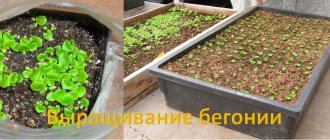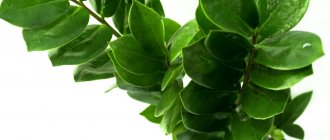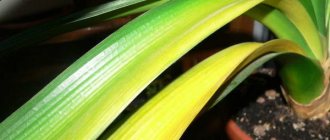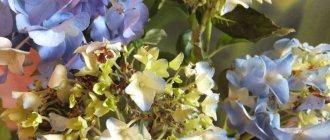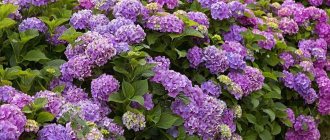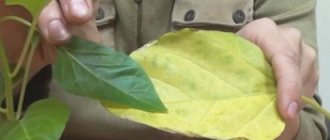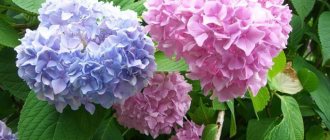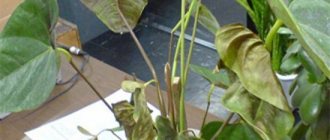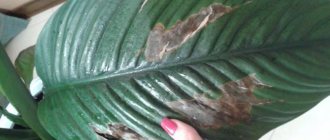Why do plants dry out and wither?
Reference. To bloom abundantly and maintain a beautiful appearance, the plant needs moderately warm, humid air and water - in moderation.
The main factors that destroy begonia and prevent it from developing normally are the following:
- Bright sun rays falling directly on leaves and flowers. Begonia is not grown on south-facing window sills or on balconies that are brightly lit all day long.
- Dry air - in an apartment it can be both in winter, when central heating is on, and in summer - if the room is well heated by the sun. In the room where the plant blooms, you need to install a household humidifier or air washer. If this is not possible, place a container of water next to the pot - a pan, pot or glass tray.
- Unregulated watering. Begonia loves moisture, but you shouldn’t overwater it - this can lead to rotting of the roots.
- Temperature changes and drafts. The flower feels best and pleases its owners with abundant flowering at a constant temperature of 16-22 degrees.
- Dense, poor soil.
- Lack of seasonal fertilizer.
You need to feed the flower all year round - choosing preparations with a high content of nutrients. It is also worth adding fresh peat-based soil to the top of the pot several times a year.
Why do plant parts dry out?
- The leaves of indoor begonias dry out most often due to drafts, stress due to moving around the apartment, and sunburn.
- Flowers fall off due to lack of nutrients, temperature changes and improper watering.
- Buds - due to dry air and lack of nutrients in the soil.
Leaf tips
Important! The simplest reason for leaf edges and edges to wilt is a lack or excess of water.
- If the tips of the leaves dry out , the air in the room is dry and the flower lacks moisture.
- If the edges turn yellow and rot , the reason is an excess of moisture, which leads to destruction of the roots.
Yellow spots also appear due to pests - aphids, whiteflies and spider mites.
Flowers
Immediately after purchasing a begonia, its flowers, as a rule, begin to fall off. This happens due to stress caused by moving and changing living conditions. If care is taken correctly, the flower will recover and new buds will appear constantly.
If the flowers continue to fall off, the begonia may not like watering and the air in the room is too dry. You need to get an air humidifier and feed the beauty with special fertilizer for flowering begonias. You cannot over-moisten the top of the pot without providing the roots with enough moisture - that is, you need to water it abundantly, but be sure to pour out the remaining water from the pan.
Leaves and buds
The buds of domestic begonias fall off and dry out due to the bright sun, which burns delicate flowers, and strong drafts - for example, when the flower stands on a window that is constantly opened for ventilation.
The flower feels best on window sills facing east. There the morning sun will not burn the buds, but will give the plant the necessary amount of light. When the buds appear, the flower should not be watered too much. A slightly dry soil is better than one with stagnant water - otherwise the bases of the buds will rot.
Attention! At the moment the buds appear, you need to fertilize the soil with a composition for flowering plants.
Abrupt change of environment
When moving a flower from room to room, transporting it to the country house or putting it on the balcony, it experiences extreme stress, since it really does not like changes in living conditions. Direct sunlight in the summer, strong drafts and heat in the winter are destructive for the blooming beauty.
Wrong light mode
An east window is an ideal place to place a flower. If this is not possible, partial shade is created for the begonia with light curtains or a screen. If you choose between a north and south window, preference is given to the south one, but always with darkening during the daytime.
Dry air
Begonia came to flower growers from the tropics, where it has ideal conditions - warm and humid all year round and partial shade from huge trees. In a city apartment, it is worth recreating these conditions as much as possible - that is, humidifying the air, since in winter and autumn the humidity drops to 15-20 percent without additional devices.
Insufficient watering
The most common reason is lack of moisture. Owners can water the flower:
- too rarely, but abundantly - in this case, the top layer of soil dries out, and the earth becomes dense and dry;
- often, but little by little - then the moisture does not reach the roots and the flower dries out.
The ideal option is to water the plant generously once a week, making sure to remove any remaining water from the tray, and as the top layer of soil dries, spray it with a spray bottle, avoiding splashes on the buds and flowers.
Lack of microelements
Reference. The plant must be fed regularly, especially when new buds and shoots are actively appearing, but at least 2 times a month.
It is worth choosing a special fertilizer - specifically for flowering begonias.
Dense soil
If the soil is not loosened, the top layer becomes stony and does not allow water and oxygen to pass through well, which leads to a lack of nutrients and stagnation of water at the roots. When the soil is dense, the leaves begin to turn yellow and fall off, and the begonia stops blooming.
Diseases
A flower can also die due to pests and disease. For example, leaves and buds can be affected by a fungal disease. There are the most common diseases that lead to wilting of begonias. The first sign of the disease is leaves withering at the edges.
Powdery mildew
If a white coating appears on the leaves, it is powdery mildew. Appears on plants that live in rooms with stagnant air and high humidity, for example, in bathrooms. At the first signs of the disease, the leaves begin to dry out, the buds and flowers fall off. For treatment, copper sulfate is used, the leaves are wiped with a solution of laundry soap.
Gray rot
A type of fungal disease caused by waterlogging of the soil. At the very beginning, gray spots appear on the leaves, which then turn black from the inside out, rot and fall off. The flowers curl, dry out, and the buds fall off before they have time to open. To combat the disease, vitriol and soap are also used, and watering and humidity in the room are regulated.
Bacterial infections
Bacterial spotting is the appearance of glassy spots on the leaves that turn brown after a short time. The leaves fall, the flower takes on a sick, unkempt appearance.
Important! To get rid of the disease, it is worth treating the flower with copper oxychloride as soon as possible.
Pests
Begonia pests are tiny, it is quite difficult to see them on leaves and flowers. They appear mainly from contaminated soil and are activated by high humidity and heat.
Nematode
Microscopic worms settle on leaves, buds and flowers, suck the juices out of the plant and poison it with the results of their vital activity. At the very beginning of the disease, spots appear on the leaves that are lighter than the main color of the leaf. After a short time, the spots turn brown and swell, resembling a burn.
It is very difficult to fight nematodes; it is easier to prevent them from infecting a flower by steaming the soil prepared for it.
Greenhouse aphid
A very fast-growing pest that can destroy a recently completely healthy plant in a few days. Insects suck out all the juices from the plant, as a result the leaves dry and curl, flowers and buds fall off. They get rid of the pest by spraying the begonia with tobacco solution several times in a row.
Once every seven days, one female can give birth to up to 100 new pests, so the fight against them must begin as soon as the first insects are noticed.
Spider mite
Attention! If a thin web is noticed on the leaves and flowers, the spider mite has begun its “work”.
The pest is activated in heat and high humidity. The leaves become white, with thin veins - like marble - then turn brown and fall off.
Root rotting
Roots begin to rot when moisture accumulates in the soil for a long time, causing various infections to spread. At the onset of the disease, it is impossible to see the signs of the disease with the naked eye, except that growth inhibition and wilting of the bush begins. Beginners make the mistake in such cases, thinking that the bush needs watering. As a result, the disease begins to develop rapidly.
Root rot is very dangerous for begonias
The rot that has already affected the tuberous part moves to the root part of the trunk and rises along the shoots. The foliage suffers from this and begins to dry out.
In this case, the first thing to do is to immediately transplant the bush into another nutrient soil. Before transplantation, the affected areas should be cut off and treated with a solution of potassium permanganate.
Note! When the roots rot, the begonia stops blooming, and the blooming flowers have a dull color and small size.
If the owner of a houseplant cannot understand why begonia flowers are withering, despite the fact that there is no visible damage or disease, then the problem lies underground. Most likely something happened to the roots of the plant.
Prevention
The main means of preventing dry leaves and buds:
- avoid drafts;
- place the flower closer to the east window, create partial shade;
- put expanded clay in the pan to prevent moisture stagnation;
- loosen the soil.
If you follow all preventive measures, feed the plant every 7-10 days with liquid fertilizers and prevent moisture from getting on the flowers, your home beauty will not have problems with dry flowers and leaves. It is also best to water the flower with settled water that has stood in a cool room for 2-3 days.
Other Possible Problems
There are several other problems that can cause yellowing and drying of begonia foliage:
- prolonged exposure to direct sunlight;
- lack of fertilizing;
- no transplants are carried out, causing the pot to become cramped;
- dry indoor air.
Healthy begonia pleases with its abundant flowering
To summarize, we can say that begonia problems arise due to improper care. Indoor plants are especially sensitive to growing conditions; each of them requires special rules and care measures. Therefore, you should approach this problem more carefully when purchasing a flower.
Care: soil, watering, temperature conditions
When begonia leaves dry, it is necessary to determine the cause, choose methods, means and methods of elimination.
- Selection of capacity. Pots should be chosen low but spacious; there should be enough space for the root system. Preference is given to ceramic containers: they allow air to pass through. Before use, they are soaked in water for several hours. If the container has already been used, be sure to thoroughly rinse, disinfect and dry it.
- Temperature changes. Reacts sharply to sudden changes in temperature and does not like drafts. This can happen when you turn on the air conditioner, heater, or move the pot from a warm room to a loggia or balcony. When the first signs of wilting appear, it is worth returning it to its previous “place of residence” and monitoring the room temperature. From October to January, when they are at rest, they are moved to a cooler place, but the air temperature should not be lower than 12 degrees.
- Watering. It is recommended to use settled or filtered warm water; under no circumstances should you water with cold tap water. Add a small amount of lemon juice or citric acid to it. Watering is carried out twice a week in hot weather and once in winter. It is advisable to carry out the procedure at the same time. Ensure good drainage so that water does not stagnate. Over-wetting the soil is unacceptable.
- Priming. The soil mixture is purchased in specialized stores or prepared independently from peat, compost, sand, and leaf soil. The main requirement is that the soil should not have a high level of acidity.
The problem may be dry indoor air. In such cases, place containers with water and carry out regular spraying. Or they place the pots on trays with sand and pebbles, which are periodically moistened.
Diseases
The flower is affected by a disease - this is why begonia leaves dry at the edges and subsequently fall off. Such troubles happen for several reasons that need to be clarified and eliminated as soon as possible.
- Downy mildew. The first sign is a whitish coating. After a short time, the tips of the leaves dry out and crumble. In the early stages, the fungicides “Fundazol” and “Moristan” are effective. For preventive purposes, spray with a solution of copper sulfate and laundry soap.
- Bacterial spotting. The plant becomes covered with brown watery spots, the inflorescences turn black. The soil is disinfected with special chemicals. For prevention, treat with copper oxychloride.
- Gray rot. Fungal infection is identified by a characteristic fluffy gray coating. Gradually the entire plant dies. It is treated with tincture of ash and potassium permanganate, treated with fungicides “Topaz”, “Fundazol”, “Topsin-M” when the first symptoms appear.
When begonia leaves curl and dry outside, the cause may be: insufficient watering, heavy rainfall, sunburn, accumulation of dust and dirt. This also happens in the case of dense plantings: the distance between bushes should not be less than 50 cm.
Causes of the phenomenon
For indoor plants
Why do the leaves around the edges of the indoor plant dry out?
Draft. With the onset of hot days, inexperienced gardeners try to ventilate the flower by placing it on a loggia or near an open window, thereby placing Begonia in conditions that are unacceptable for it.
- Sun. Considering the fact that we have a tropical plant on our hands, we try to give it as much light as possible and place it in the most illuminated place in the house. But in return we get burnt and drying leaves. The cause of this phenomenon was direct rays of the sun.
- Dry air . Typically, this factor occurs in winter due to the fact that heating devices start working, which very dry the air. Read about proper care of begonias in winter here.
- Lack of fertilizers. Or an incorrectly selected set of nutrients.
- Attacks of pests and diseases.
- Stress. A flower is also a living being. And therefore it can react to a careless attitude towards it or a sharp change in growth conditions.
- Composition of water. When the wilting of leaves begins with the appearance of brown pigmentation on them, we can safely say that the reason is the chemical composition of the irrigation liquid. You can read about how and what to water this plant here.
For those living in open ground
- Excessively warm and dry weather.
- Lack of irrigation.
- Lack of weeding of beds.
Pests
Among the pests of begonias we can distinguish: •spider mites; •leaf and root-knot nematodes; •greenhouse aphids.
Spider mite
One of the worst pests is the spider mite. It is almost invisible on indoor plants. Only if you look closely you can see dark dots on the bottom of the leaves, which, when touched, show signs of life. The tiny spider feeds on cell sap. First, small transparent dots appear on the leaves, then they dry out and fly off.
Ticks prefer to live in a dry place, so for prevention you should spray them with water from a spray bottle more often. If the mite has already appeared, you need to tear off and destroy all the yellowed leaves on which there is a massive accumulation of pests. Place the flower in a container and wash well under running water. After drying, treat with one of the anti-tick products.
Repeat the treatment 2 more times with an interval of 5 days.
Leaf nematodes
Leaf nematodes, unlike mites, prefer a moist environment. These filamentous microscopic worms parasitize leaves that wither, turn brown and dry out. The root-knot nematode manifests itself in the appearance of galls on roots and stems. There are no effective measures to combat this pest. The plant must be destroyed along with the soil and pot.
